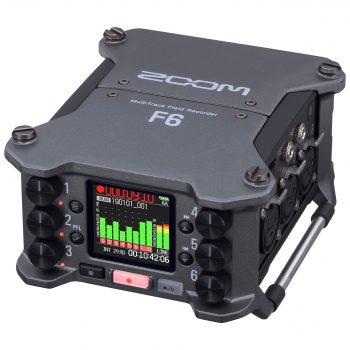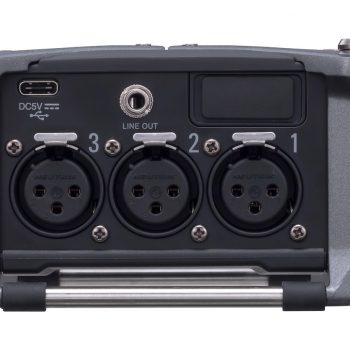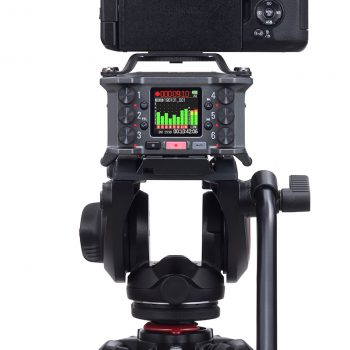
Review: Zoom F6 Portable Field Recorder
Zoom’s tiny F6 uses 32-bit floating point converters to overcome the need for user-adjustable input gain. How does it sound?
I recently reviewed Zoom’s F8n [see issue 132] and both it and their new F6 demonstrate that Zoom is continuing a strong evolution of design in its products. There will never be a single device that is perfect for all needs, but the F6 is an interesting development that is, in many ways, a real game-changer for location recording.
I take a pragmatic approach to the equipment I use; the best tool for a job is the tool that lets me get that job done. That means I judge microphones and recording equipment with my ears, not by some arbitrary value of reputation. The ultimate test of any equipment is if you trust it enough to use it for paying gigs. This review is based on my experience using the F6 while capturing content for a current project.
SURPRISINGLY SMALL
The F6 is tiny but surprisingly sturdy. Zoom has moved towards more robust housings for their units, which I very much appreciate. Weighing just 500 grams, it’s about a quarter of the weight of my current main recording device – that’s an important consideration for location recording.
It has a standard 1/4 inch camera thread on the bottom, allowing it to be mounted on a camera tripod. One of the best features is a supplied bracket that screws on to the top, as seen on Zoom’s other F series recorders; this allows a camera to be mounted on top, but with the right thread adapter it could also be used to mount a microphone or stereo bar. Combining the F6 with a tripod and top-mounted mics gives you a free-standing rig that would be excellent for environmental recording.
The F6’s interface is clear and easy to read, and I was quickly able to navigate the menus without needing the manual. The buttons are simple and easy to use, with the exception of the power button which is hidden on the side. I didn’t mind this too much as it avoided accidental triggering, but it was tricky to switch the F6 on and off without specifically looking at it. Don’t try this in the dark without a torch.
The six inputs all use full-size XLR sockets rather than miniature TA3s or similar, which is interesting considering the F6’s small size and means you don’t need special cables or adapters. Unlike Zoom’s other F-series recorders, the F6’s XLR inputs are not combo connectors; if you want to plug a guitar or keyboard into it you’ll need a DI box for guitars or an adaptor cable for keyboards. This suggests that the F6 is intended for location recording rather than for recording musicians, although it can also be used as a USB interface.
The F6 includes a comprehensive SMPTE timecode system built around a Temperature Compensated Crystal Oscillator (TXCO) that claims an accuracy of 0.2ppm, with timecode in and out on a single 3.5mm TRS jack. SMPTE is not something I’ve ever needed for my work, so I did not test this feature.
I’m a big fan of the powering options provided for the F6. It comes with an internal battery bay and adapter in which you can mount four AA batteries. It also allows you to directly attach Sony L-Series rechargeable batteries, and, finally, it can be powered via a USB 2.0 cable. The optional AD-17 AC adaptor actually connects via the USB port, so it should be easy to power the F6 from a power bank or from USB bus power when used as an interface. The combination of these three options gives you a wealth of choices for powering the unit.
NEED TO KNOW
ROUTING & RECORDING MODES
The F6 automatically assigns inputs to tracks: input one to track one, input two to track two, etc. It can also capture a stereo mix of all the tracks made from the internal mixer during the recording; an option that’s available for most of the recording modes. Even though the F6 has six XLR inputs it can record many more tracks derived from those six inputs, depending on the chosen recording mode.
There are four recording modes: Linear, Float, Dual and MP3. In Linear mode the F6 is like any other field recorder, recording 16-bit or 24-bit wav files in the industry-standard Linear PCM file format. In Float mode it records 32-bit single precision floating-point wav files, which Zoom refers to as ‘32-bit Float’. In Dual mode it records the Linear PCM wav files (choice of 16-bit or 24-bit) and the 32-bit Float wav files at the same time, creating two tracks for each input. In MP3 mode it records mp3 files.
The Dual mode quickly became my default operating mode. It allows up to 14 tracks to be recorded simultaneously: six Linear PCM tracks (16-bit or 24-bit), six 32-bit Float tracks, and the stereo mix from the internal mixer. The files are named with the recording date and track number, and the 32-bit Float wavs have an additional tag. In this mode you can adjust the recording levels of the Linear PCM tracks just like with any other field recorder, but not the 32-bit Float tracks – assumedly so that anything that may peak in the Linear PCM tracks will be safely captured in the 32-bit Float tracks.
He bankrolled this hopeless bunch of kids and gave us the keys to a very expensive, well-kitted out studio, and told us to go for it
AN ODD CHOICE
One aspect of the F6 that I find unusual is the setup of the input gain. Zoom decided that because of the wide dynamic range of the 32-bit converters (wider than any microphone can produce) there is no reason for the user to adjust the input gain when recording the 32-bit Float files. The input gain is a set value locked within the device, and optimised for the 32-bit AD converters. The Trim control only affects the recorded level of the 24-bit or 16-bit wav files and the mp3 files, which are all derived from the 32-bit Float signal and amplified or reduced accordingly. It is essentially a post-process as you would apply in your DAW after transferring the files.
This goes against everything I was ever taught about recording audio. The rule of thumb was always to record as strong a signal as possible while avoiding peaking, so that there is less chance of introducing unwanted noise from within the signal chain. The F6 removes this choice and applies its own gain. I will say that from my experience so far it does a pretty good job, but as a professional device I don’t think it should be making these kinds of decisions for me.
For quiet content I found that using the 32-bit Float files did introduce a bit of unwanted noise because of the need to boost them to workable levels in post. Nonetheless, if you’re using the F6 in Dual mode and using the 32-bit Float files as backups in the event of clipping the Linear PCM files, you’re not going to be worried about a bit of noise if it makes the difference between a useful recording and a clipped recording.
If it is possible to change this in a Bios update, so the user has the option to adjust the recorded level of the 32-bit Float files, I would request that Zoom consider doing so because it is the one aspect of this device that I am uncomfortable with. It’s certainly not a deal-breaker, but it is an odd choice.
WHAT I HEAR
Regardless of my concerns about the lack of a gain control for the 32-bit files, I will say that the F6 does an excellent job of capturing high level input content. I placed it within a couple of meters of a high-speed country train passing by and also at the end of a runway where airliners were taking off, and the clarity of the captured sound was wonderful. For years, I have spent a lot of time riding input levels on 16-bit and 24-bit devices to capture a strong signal without introducing distortion, so the ‘fire and forget’ nature of the F6’s 32-bit Float recording mode is well worth the price of entry.
The 32-bit Float format is extremely important to our industry, but it is also a complex topic that I will cover in more detail in a later issue.
MORE DETAILS
Standard size SD cards (SDHC and SDXC) are the capture media for the F6, with the SD slot hidden behind the rechargeable battery bay. SD cards up to 512GB capacity can be used, giving many hours of continuous recording.
Sampling rates from 44.1k to 192k are available, but some of these have limitations depending on the number of tracks and the recording mode you’re using. For example, there is a useful ambisonic linking format for those using ambisonic microphones: it syncs up the input levels for four channels, but limits the sampling rate to 96k when recording at 32-bit. I found it was a balancing act between the number of channels and the available sampling rates. That said, I am pretty sure I have experienced this with every recording device I have ever used. Similarly, the pre-record function offers between one and six seconds of pre-record time, depending on the sampling rate.
The F6 also offers wireless control by purchasing the optional BTA-1 Bluetooth adaptor and downloading the accompanying app, but the app is only available for Apple devices. This is something Zoom does that I find strange. I am aware that Apple is the dominant smartphone seller in Japan and with Zoom being a Japanese company I can certainly understand why they would develop the app for Apple phones. But the number of Android users worldwide is a massive market, so I really cannot understand why they would not provide this function on Android devices as well. I was unable to test this feature, but I’m sure many would find it useful.
CONCLUSION
Overall the F6 is a device I can see myself using on a regular basis. It is small, lightweight, simple to use, and, most importantly, it captures content effectively in the current take on 32-bit Float recording. I need a device that does this, and the F6’s price point makes it a very appealing choice.
In an industry where some of the big companies have become complacent with their products, I really enjoy seeing Zoom strive time after time to advance their product line. And while not all their devices are must-haves, I think the F6 just might be.






















“For quiet content I found that using the 32-bit Float files did introduce a bit of unwanted noise because of the need to boost them to workable levels in post. Nonetheless, if you’re using the F6 in Dual mode and using the 32-bit Float files as backups in the event of clipping the Linear PCM files, you’re not going to be worried about a bit of noise if it makes the difference between a useful recording and a clipped recording.”
As (AFAIK) the 16 and 24 bit files created by the F6 by are produced by converting the 32bit FP stream produced by the composite dual-ADC system, in much the same way you do it externally using a DAW (or audio file editor), I doubt that using 24 bit files can provide any advantage at all.
As far as the applied gain (that is, the resulting audio level) is the same in both cases, 24 bit files produced by the F6 should give you exactly the same results that you will get by converting the original 32 bit FP files to 24 bit “after the fact”.
To reduce the noise floor on quiet passages you’d need to act on the actual analog preamp gain. Which is something that (AFAIK) the F6 hardware can not do.
BTW, keep in mind that the equivalent input noise of the F6 is so low (<= -127dBu) that it's negligible WRT the self-noise of any microphone I know about, being orders of magnitude lower than that. That is, the noise floor that you can see (or even hear) on the recorded file(s) is basically just the self-noise of the connected mics (plus the actual acoustic background noise of the ambient captured by the mics) amplified (together with the signal) more than 5600 times (+75dB) by F6's preamps.
That is to say that, if you hear too much noise, blame the mics. By actually recording a huge dynamic range, the F6 is only showing you how much noise they produces, and how limited is their dynamic range (e.g., most condensers won't give you more then 80dB. Cheap ones even less. Compare that with the dynamic range provided by the F6…).
“If it is possible to change this in a Bios update, so the user has the option to adjust the recorded level of the 32-bit Float files, I would request that Zoom consider doing so […]”
Perhaps that might be done… but it would be completely pointless.
The only effect of such an operation would be to "shift" the level of the whole signal (including its noise floor) within its 32 bit FP representation.
That is, it's exactly the same as adjusting the track level in your DAW. The recorded noise floor will shift together with the signal level. It will increase as you increase the signal level, and vice-versa.
In other words, there would be absolutely no effect on the S/N ratio, dynamic range, etc.
Whether you let F6 do it "inline" or you do it later in your DAW makes no difference whatsoever.
That's why Zoom have not included such an option in the beginning. It would simply make no sense to do so in such a system.
If you want to get rid of the possibly annoying noise floor on the "silent" passages of the audio, apply an expander to your recorded tracks and/or write automations to do the same thing. 😉
My 2¢.